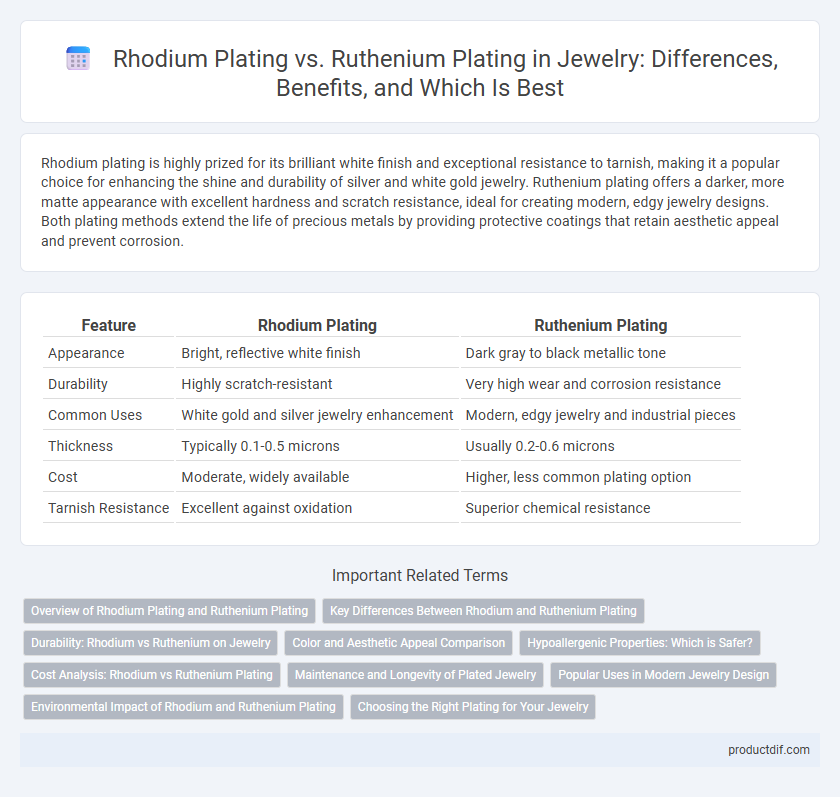Rhodium plating is highly prized for its brilliant white finish and exceptional resistance to tarnish, making it a popular choice for enhancing the shine and durability of silver and white gold jewelry. Ruthenium plating offers a darker, more matte appearance with excellent hardness and scratch resistance, ideal for creating modern, edgy jewelry designs. Both plating methods extend the life of precious metals by providing protective coatings that retain aesthetic appeal and prevent corrosion.
Table of Comparison
| Feature | Rhodium Plating | Ruthenium Plating |
|---|---|---|
| Appearance | Bright, reflective white finish | Dark gray to black metallic tone |
| Durability | Highly scratch-resistant | Very high wear and corrosion resistance |
| Common Uses | White gold and silver jewelry enhancement | Modern, edgy jewelry and industrial pieces |
| Thickness | Typically 0.1-0.5 microns | Usually 0.2-0.6 microns |
| Cost | Moderate, widely available | Higher, less common plating option |
| Tarnish Resistance | Excellent against oxidation | Superior chemical resistance |
Overview of Rhodium Plating and Ruthenium Plating
Rhodium plating involves coating jewelry with a bright, reflective white metal from the platinum group, offering superior resistance to tarnish and corrosion while enhancing durability and visual appeal. Ruthenium plating, also from the platinum group, provides a darker, more matte finish that is highly scratch-resistant and ideal for creating contemporary jewelry designs with strong oxidative stability. Both plating types improve the longevity and aesthetic quality of precious metals, but rhodium is favored for a brilliant shine, whereas ruthenium is chosen for its unique color and toughness.
Key Differences Between Rhodium and Ruthenium Plating
Rhodium plating offers a brilliant, reflective white finish and superior corrosion resistance, making it ideal for enhancing white gold and silver jewelry's durability and shine. Ruthenium plating provides a darker, more oxidized appearance with excellent hardness and scratch resistance, often used for unique, contemporary jewelry designs. Both platings improve jewelry longevity, but rhodium excels in brightness and tarnish protection, while ruthenium stands out for its bold, matte aesthetic and robustness.
Durability: Rhodium vs Ruthenium on Jewelry
Rhodium plating offers excellent corrosion resistance and maintains a bright, reflective finish but tends to wear off after 6 to 12 months, requiring periodic reapplication. Ruthenium plating provides superior hardness and scratch resistance, extending the lifespan of jewelry with a durable, tarnish-resistant surface that lasts significantly longer than rhodium. Choosing between rhodium and ruthenium plating depends on the desired balance between initial brilliance and long-term durability in fine jewelry maintenance.
Color and Aesthetic Appeal Comparison
Rhodium plating offers a bright, reflective white finish that enhances the brilliance of silver and white gold jewelry, creating a high-luster, mirror-like appearance. Ruthenium plating presents a darker, gunmetal gray to black tone, providing a modern, edgy aesthetic favored in contemporary jewelry designs. Both platings improve surface durability, but rhodium is preferred for classic, radiant looks while ruthenium suits bold, avant-garde styles.
Hypoallergenic Properties: Which is Safer?
Rhodium plating is highly regarded for its hypoallergenic properties, making it safer for individuals with sensitive skin or metal allergies, as it creates a non-reactive, smooth surface that resists tarnishing. Ruthenium plating also offers hypoallergenic benefits due to its inert nature, but it is less commonly used in jewelry, with slightly lower corrosion resistance. Overall, rhodium plating remains the preferred choice for hypoallergenic jewelry coatings due to its widespread availability and proven biocompatibility.
Cost Analysis: Rhodium vs Ruthenium Plating
Rhodium plating typically costs more than ruthenium plating due to rhodium's rarity and high demand in the jewelry industry, with prices fluctuating significantly based on market conditions. Ruthenium plating offers a more cost-effective alternative, providing a durable, dark finish at a lower price point while maintaining resistance to tarnish and wear. Jewelry manufacturers often choose ruthenium plating to reduce production costs without compromising quality, especially for pieces requiring a unique black or gray metallic sheen.
Maintenance and Longevity of Plated Jewelry
Rhodium plating enhances jewelry durability by providing a hard, corrosion-resistant surface that maintains shine for 1 to 2 years with proper care. Ruthenium plating offers superior resistance to scratches and tarnish, often lasting up to 3 years without significant maintenance. Regular gentle cleaning and avoiding harsh chemicals extend the longevity of both plating types, preserving the jewelry's aesthetic appeal.
Popular Uses in Modern Jewelry Design
Rhodium plating is widely used in modern jewelry design for its brilliant white finish and excellent tarnish resistance, making it a popular choice for enhancing the appearance of white gold and silver pieces. Ruthenium plating offers a unique dark, gunmetal-gray finish that appeals to contemporary designers seeking bold, edgy aesthetics in rings, bracelets, and men's jewelry. Both plating techniques improve durability, but rhodium remains the preferred option for traditional elegance, while ruthenium suits avant-garde and fashion-forward collections.
Environmental Impact of Rhodium and Ruthenium Plating
Rhodium plating, derived from a rare and highly valuable metal, often involves energy-intensive mining processes and the use of toxic chemicals that pose significant environmental hazards. Ruthenium plating, sourced from a platinum group metal with a lower extraction footprint, generally employs less harmful substances during application, resulting in a comparatively smaller ecological impact. Both plating methods require responsible waste management to minimize environmental pollution and ensure sustainable production practices in the jewelry industry.
Choosing the Right Plating for Your Jewelry
Rhodium plating offers a brilliant, mirror-like finish with excellent resistance to tarnish and scratches, making it ideal for white gold and silver jewelry that requires frequent wear. Ruthenium plating provides a durable, dark-gray to black coating, enhancing modern designs with a unique matte or glossy finish suitable for statement pieces and contemporary styles. Selecting between rhodium and ruthenium plating depends on desired aesthetic, durability needs, and maintenance preferences for long-lasting jewelry appeal.
Rhodium Plating vs Ruthenium Plating Infographic

 productdif.com
productdif.com